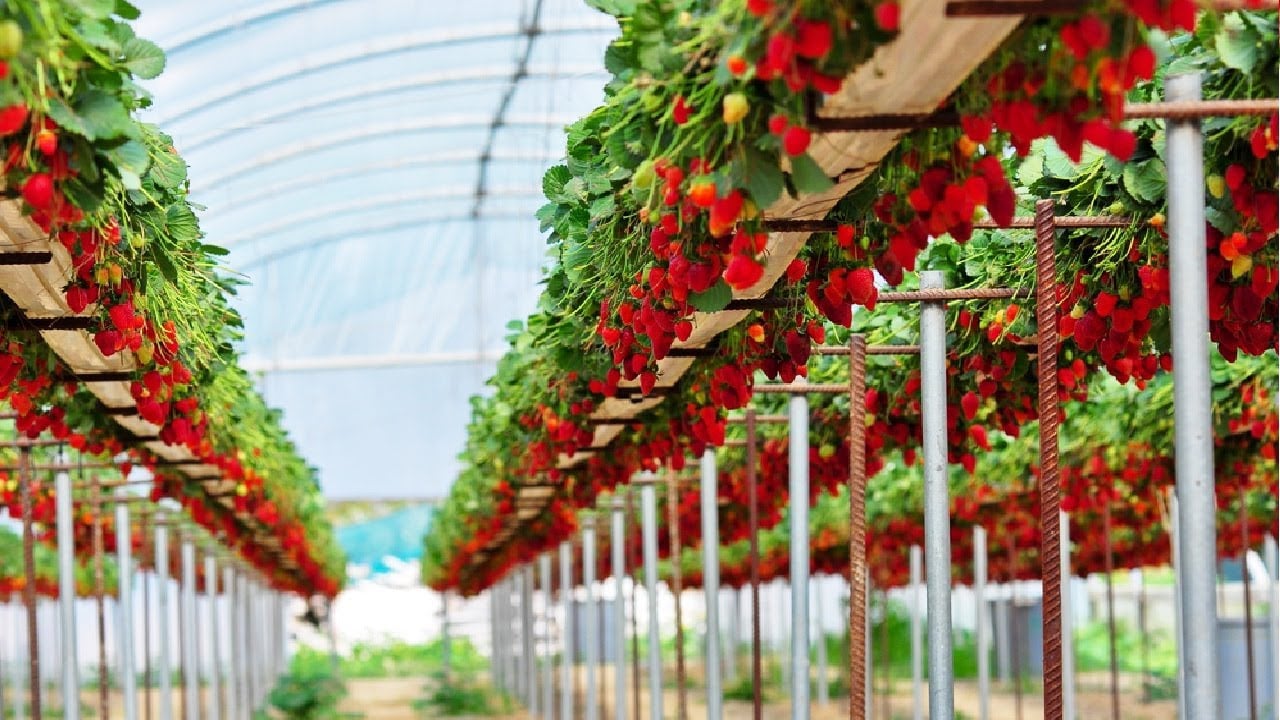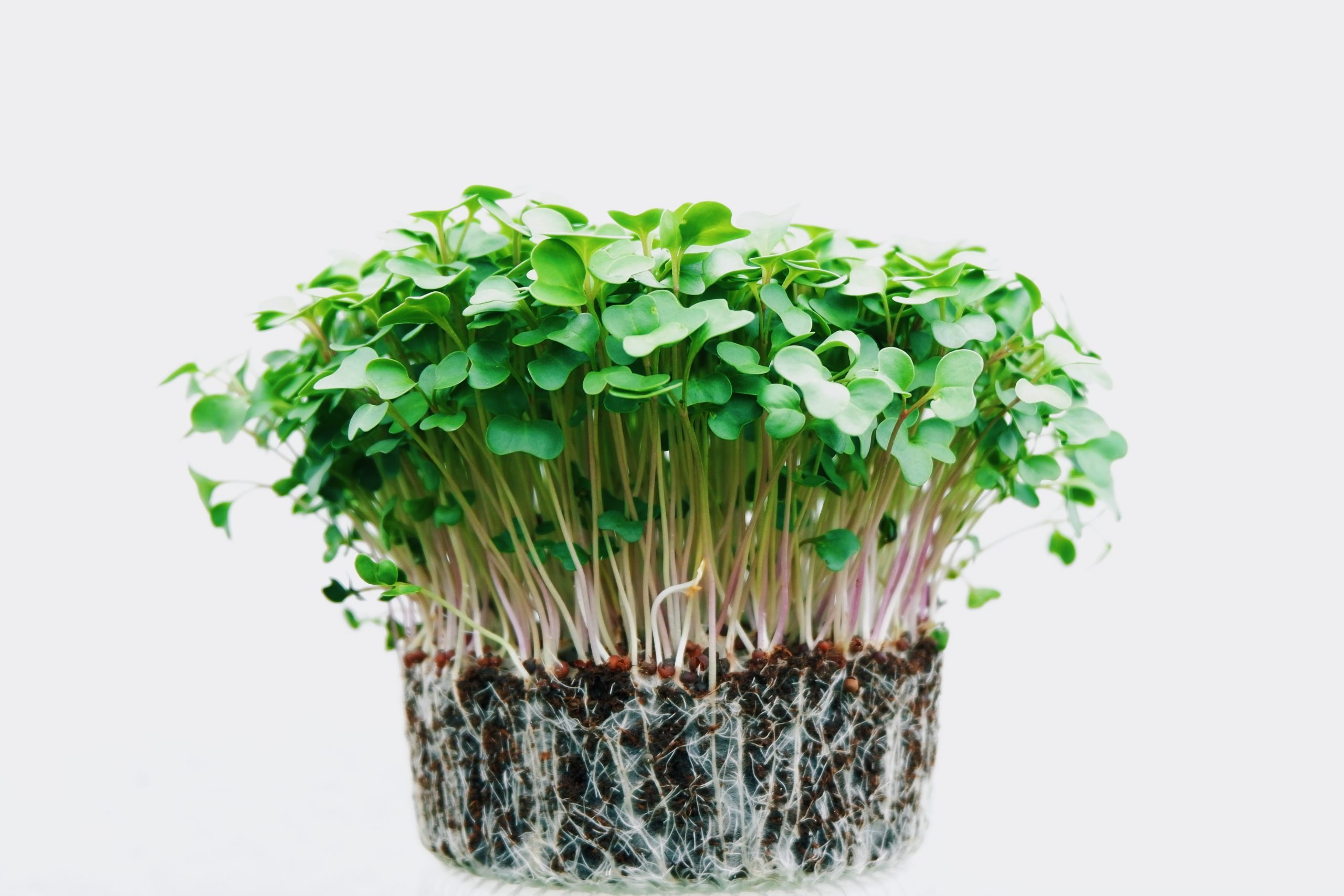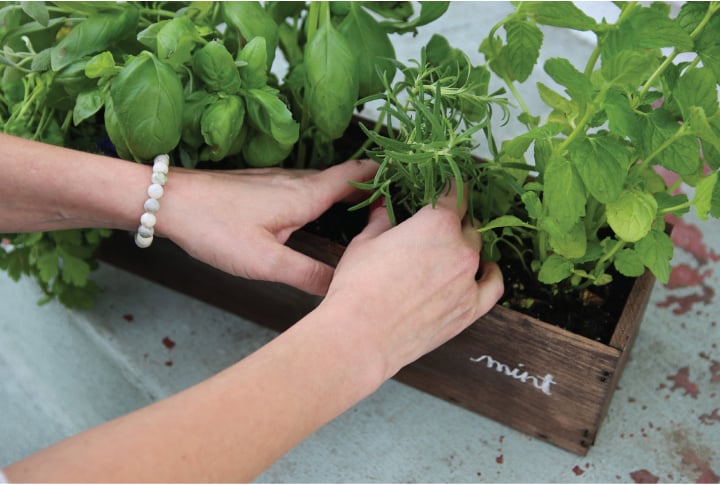22 Best Indoor Plants and Trees to Brighten Your Living Spaces
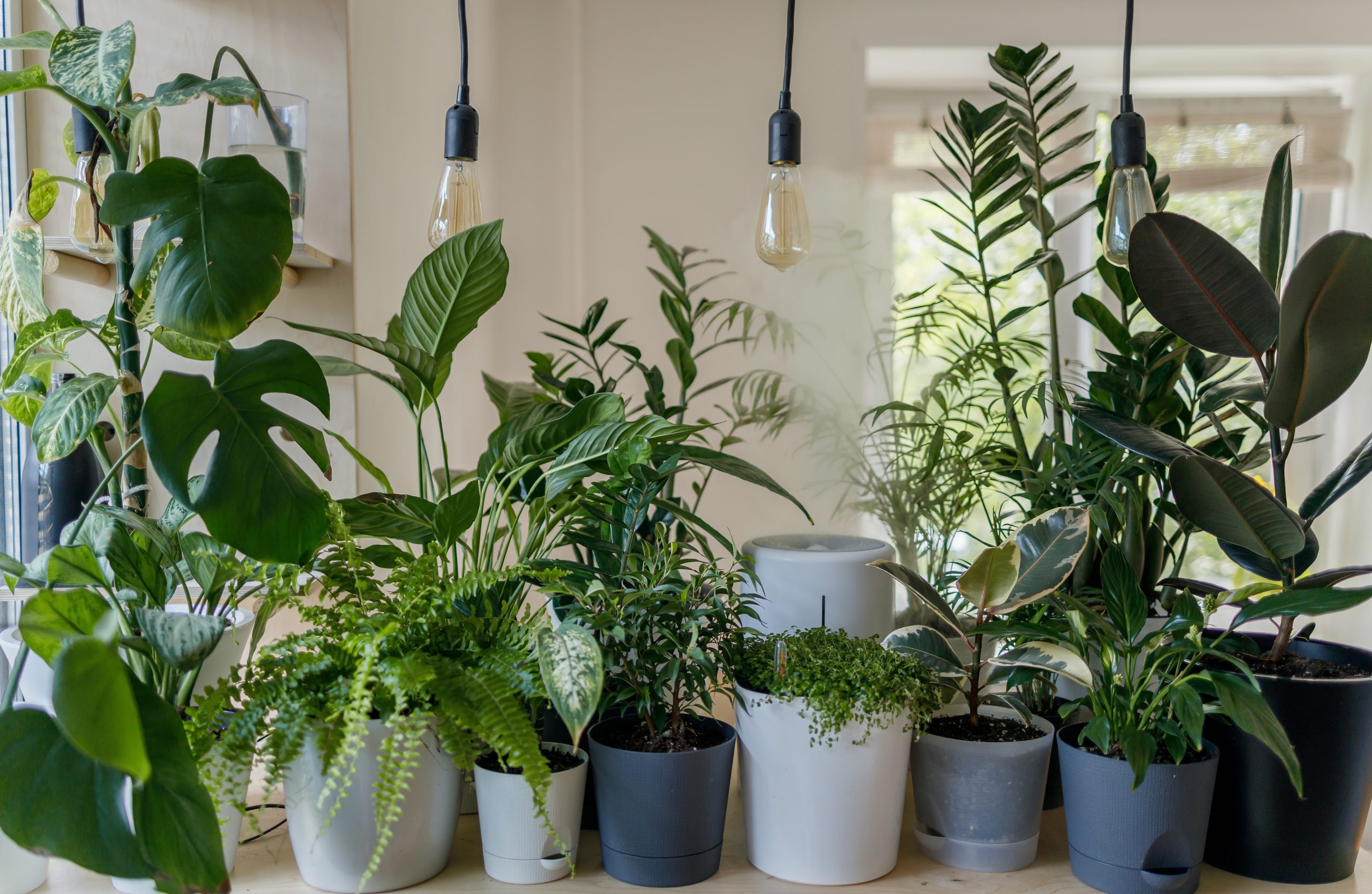
Table of Contents
Can we all agree that indoor trees and plants look beautiful inside our homes and offices? They are not only a great way to add some vibrant and aesthetic appeal to your home or office, but also, they bring numerous health benefits, which we all know without any discussion.
You might have come across so many options that deciding which indoor plants and trees are best for your home would be overwhelming! In this article, we’ll showcase the 22 best indoor plants and trees that will surely brighten up your living spaces and bring a sense of tranquillity to your home.
We have also provided the links for these plants from where you can buy them. Please notice that not all natural plants are available online due to various reasons.
For that purpose, we have added an artificial version of them.
Best Indoor Trees to Grow in Living Room: Plants for Your Home
1. Fiddle Leaf Fig
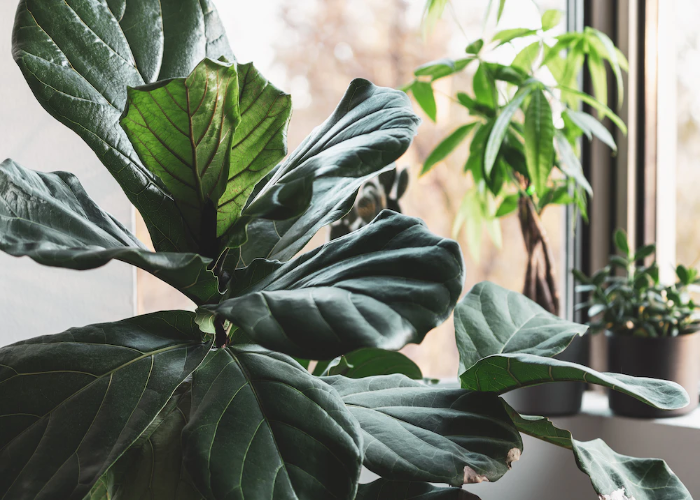
The Fiddle Leaf Fig is a tropical plant with large, violin-shaped leaves. These can grow up to 12 inches long. However, talking about the entire plant, it can grow up to 6 feet tall. It is native to tropical regions of West Africa and is commonly used as a decorative statement piece in modern home interiors.
Maintenance Level: Moderate
Benefits: Known for its air-purifying ability. Making it an excellent plant for improving indoor air quality.
Suitable spot: Fiddle Leaf Fig thieves in bright, indirect light and prefers a consistent environment, so keeping it in a room with a stable temperature and away from draft plants is best for it.
How to Maintain it: Fiddle Leaf Figs should be watered once a week, and their leaves should be dusted regularly to keep them clean and healthy.
2. Rubber Plant
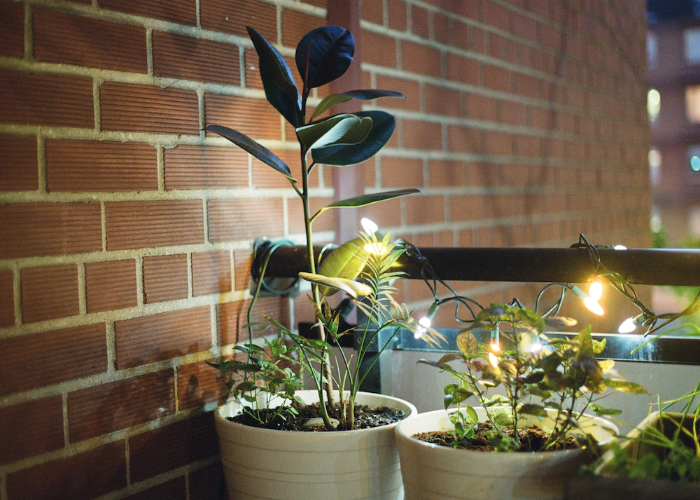
Rubber Plant has large, glossy leaves that are typically dark green but can also be in different colours, such as pink or brown. It’s a popular houseplant due to its hardiness and ability to thrive in various conditions. It can be one of the best indoor plants from a decorative point of view.
Maintenance Level: Easy
Benefits: This plant is good at air-purifying, which makes it a perfect plant for improving indoor air quality.
Suitable spot: Rubber Plants flourish in bright, indirect light but can tolerate lower light conditions for nearly a week. This makes them versatile plants for different home decor, especially with white themes.
How to Maintain it: Rubber plants should be watered when the top inch of soil is dry, and their leaves should be wiped down with a damp cloth to keep them clean so that the beauty of these indoor trees remains the same.
3. Snake Plant
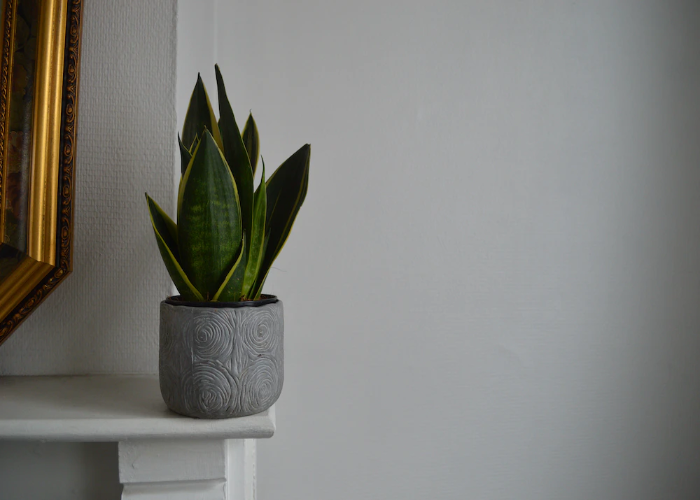
Snake Plant, also known as mother-in-law’s tongue, has tall, sturdy leaves that grow upright and can range in colour from dark green to yellow-green. It’s a low-maintenance indoor tree that can grow in various conditions.
Maintenance Level: Easy
Benefits: These indoor trees remove toxins such as formaldehyde and benzene from the air.
Suitable spot: Snake Plants can survive in a range of light conditions, from low to bright, but should be kept out of direct sunlight. This indoor tree can also tolerate various temperatures and is an excellent plant for bathrooms or other areas with high humidity.
How to Maintain it: Snake Plants should be watered infrequently and restricted, as it may lead to root rot. This plant’s leaves should be wiped with a damp cloth to keep them clean, or these indoor trees will lose their beauty.
4. Norfolk Island Pine
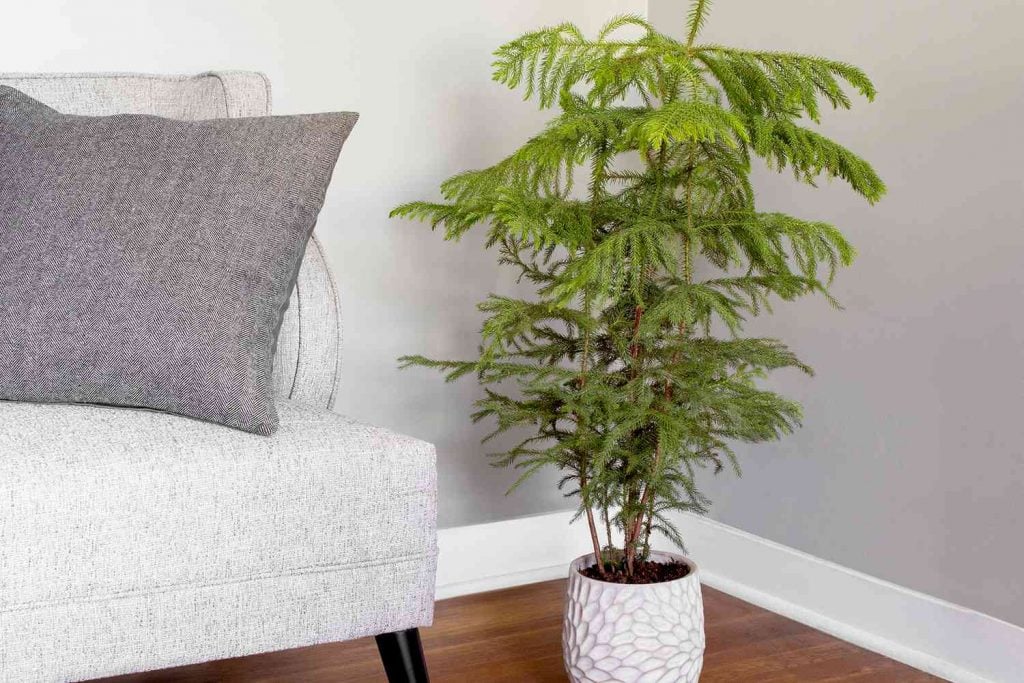
Norfolk Island Pine is a coniferous indoor tree with soft, feathery needles resembling a Christmas tree. These indoor treescan grow up to 6 feet tall and are commonly used as an indoor Christmas tree during the holiday season.
Maintenance Level: Moderate
Benefits: This indoor tree is known for its air-purifying abilities, making it a great plant for improving indoor air quality.
Suitable spot: These indoor trees thrive in bright, indirect light and prefer a consistent environment, so keeping them in a room with stable temperatures and away from drafts is best.
How to Maintain it: These indoor trees should be watered when the top inch of soil is dry lest no, and their needles should be misted occasionally to maintain humidity levels.
5. Swiss Cheese Plant
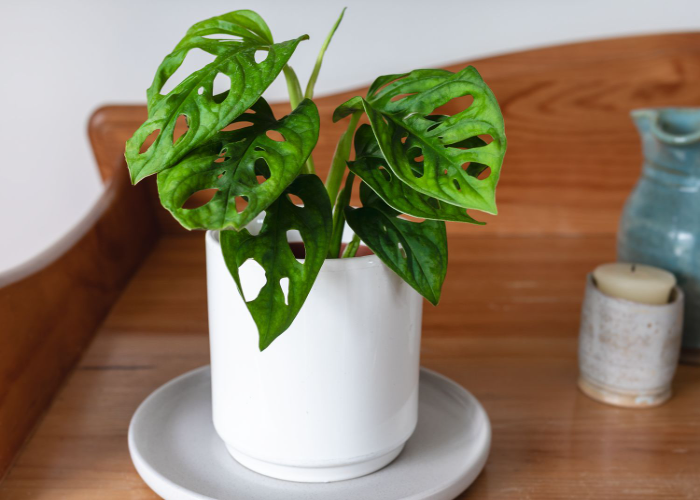
The Swiss Cheese Plant, or Monstera Deliciosa, is a beautiful and unique indoor plant with large, perforated leaves that add a tropical touch to any room. These fast-growing indoor trees can reach up to 10 feet tall if given proper environment and care.
Maintenance Level: Moderate
Benefits:
- The Swiss Cheese Plant is beautiful and adds a tropical and exotic feel to any indoor space.
- These indoor trees also help to purify the air by removing harmful toxins.
Suitable spot: It is best to keep the Swiss Cheese Plant in a spot with bright, indirect light, but it can also tolerate low light conditions. It also needs a warm and humid environment.
How to Maintain it: The Swiss Cheese Plant needs well-draining soil and regular watering, but don’t overwater it. It also benefits from regular misting to keep the leaves humid. Pruning is necessary to keep its size manageable.
6. Chinese Money Plant
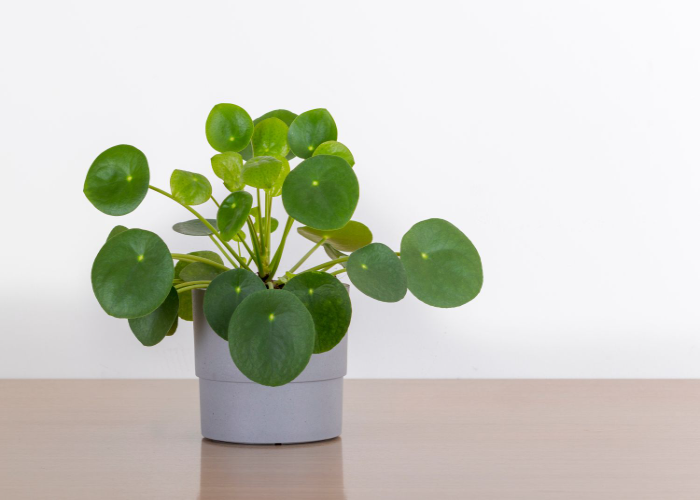
The Chinese Money Plant, or Pilea Peperomioides, is a unique and popular houseplant with round, pancake-like leaveson long, thin stems. It is easy to grow and propagate, making it an excellent choice for beginners.
Maintenance Level: Easy
Benefits:
- This houseplant symbolises good luck and prosperity in some cultures.
- It is also good with air-purifying properties.
Suitable spot: Keeping the Swiss Cheese Plant in a spot with bright, indirect light is best, but these indoor trees can also tolerate low light conditions. It also needs a warm and humid environment.
How to Maintain it: The Chinese Money Plant needs regular watering, but don’t overwater these indoor trees as they can cause root rot. They also benefit from regular fertilisation and occasional pruning to encourage bushier growth.
7. Bird of Paradise
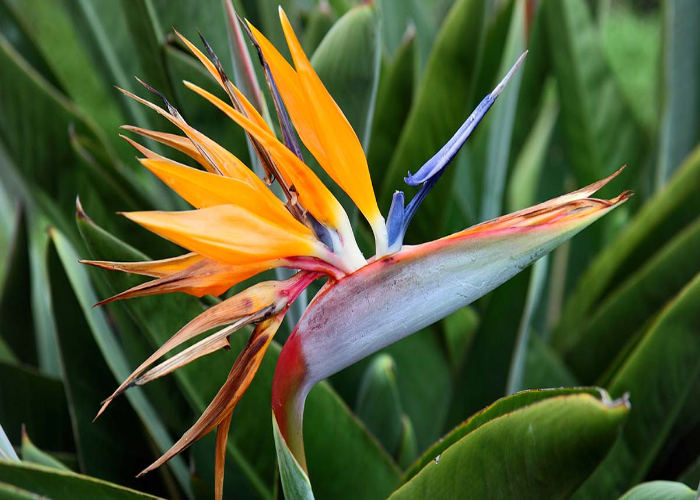
The Bird of Paradise, also known as Strelitzia, is a stunning tropical houseplant known for its unique and colourful blooms resembling a bird’s head. It is a slow-growing plant that can reach up to 5-6 feet in height.
Maintenance Level: Moderate to Excessive
Benefits:
- Used for decorative purposes in floral arrangements.
- Like all the other indoor plants, The Bird of Paradise has excellent air-cleaning abilities.
Suitable spot: The Bird of Paradise prefers bright, indirect light and a warm environment. It also needs well-draining soil and regular watering.
How to Maintain it: This tree needs regular watering and fertilisation during the growing season but less during the dormant season. It also needs occasional pruning to maintain its size and shape.
8. Weeping Fig
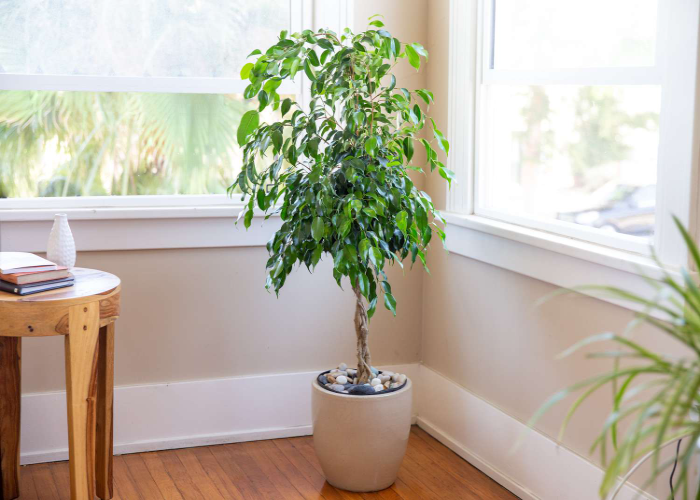
The Weeping Fig, or the Ficus Benjamina, is a famous indoor tree with delicate, drooping branches and glossy, dark green leaves. It is a fast-growing plant that can reach up to 6-8 feet in height.
Maintenance Level: Moderate to Excessive
Benefits:
- These indoor trees are believed to bring good luck and prosperity in some cultures.
- They also remove many toxins from the air for a better lifestyle.
Suitable spot: The Weeping Fig prefers bright, indirect light but can tolerate low-light conditions. It also needs well-draining soil and a warm environment.
How to Maintain It: The Weeping Fig needs regular watering and fertilisation during the growing season. It also gets benefits from occasional pruning to maintain its size and shape.
9. Ponytail Palm
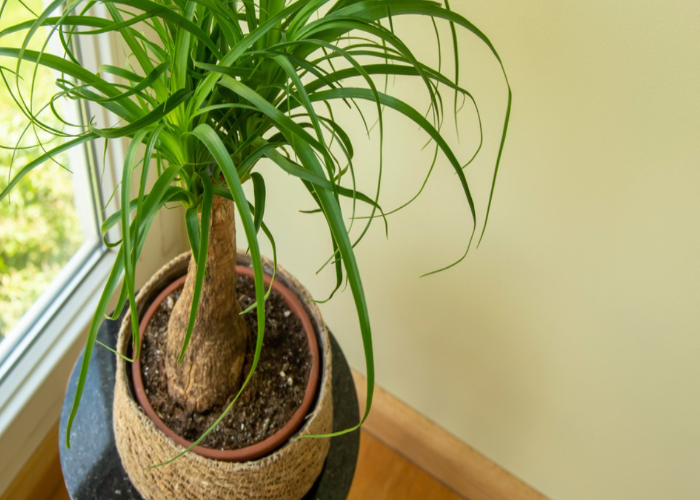
The Ponytail Palm, also known as the Elephant’s Foot, is a slow-growing succulent with a thick, swollen stem at its base and long, thin leaves resembling a ponytail. It is a hardy plant that can live for decades with proper care.
Maintenance Level: Easy
Benefits: Air-purifying abilities of this indoor tree can help remove harmful toxins.
Suitable spot: This indoor tree prefers bright, indirect light and can thrive in most locations, including low-light areas. Keeping it in a well-draining pot with a sandy soil mix is best.
How to Maintain it: Watering this plant once a week is sufficient. Just make sure the soil dries out completely when you water next time. The Schefflera are pruned to control their size and shape. It benefits from occasional fertilisation during the growing season.
10. Dracaena Marginata
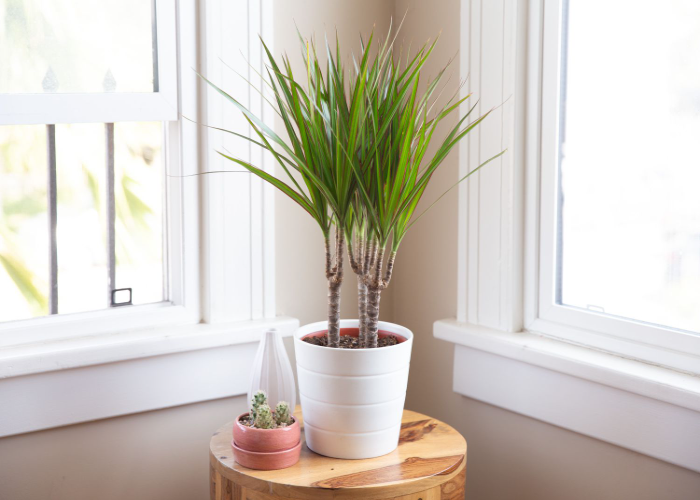
The Dracaena Marginata, also known as the Madagascar Dragon Tree, is a popular indoor tree that features long, thin leaves with a red margin. It is a slow-growing plant that can reach up to six feet tall over time.
Maintenance Level: Easy
Benefits:
- The Dracaena Marginata is an adequate air purifier and can help remove harmful toxins from the air in your home.
- It is a low-maintenance houseplant that can thrive in a variety of conditions.
Suitable spot: The Dracaena Marginata prefers bright, indirect light but can also tolerate lower light conditions. It’s best to keep it in a well-draining pot with a soil mix that is evenly moist.
How to Maintain it: This indoor plant survives in bright, indirect light and prefers to be kept dry, so be careful not to overwater. It can tolerate a wide range of temperatures, but the warm temperature suits it. This indoor plant can get benefits from occasional fertilisation during the growing season.
11. Dracaena Fragrans
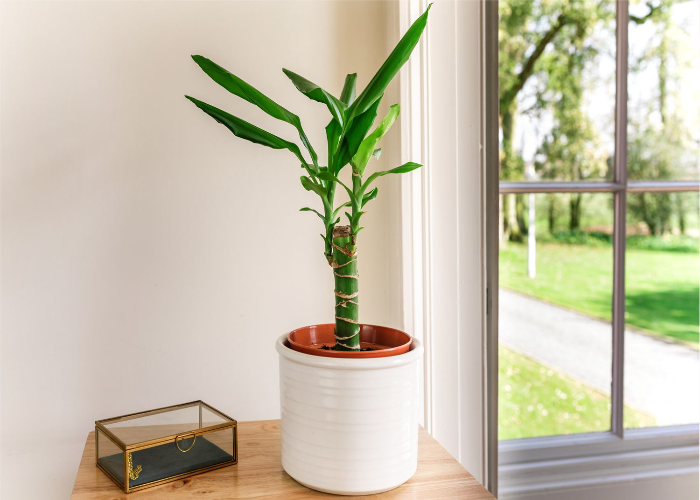
The Dracaena Fragrans, also known as the Corn Plant, is a popular indoor tree with long, green leaves with yellow stripes. It is a slow-growing plant that can reach up to six feet tall over time.
Maintenance Level: Easy
Benefits:
- An adequate air-purifying indoor tree can help remove harmful toxins from the air in your home.
- A low-cost indoor tree that can survive in various conditions.
Suitable Spot: The Dracaena Fragrans prefers bright, indirect light but tolerates lower light conditions. It is best to keep it in a well-draining pot with an evenly moist soil mix.
How to Maintain it: Watering this plant once a week is sufficient. Just make sure the soil dries out completely when you water next time. The Schefflera are pruned to control their size and shape. It benefits from occasional fertilisation during the growing season.
12. Lemon Tree
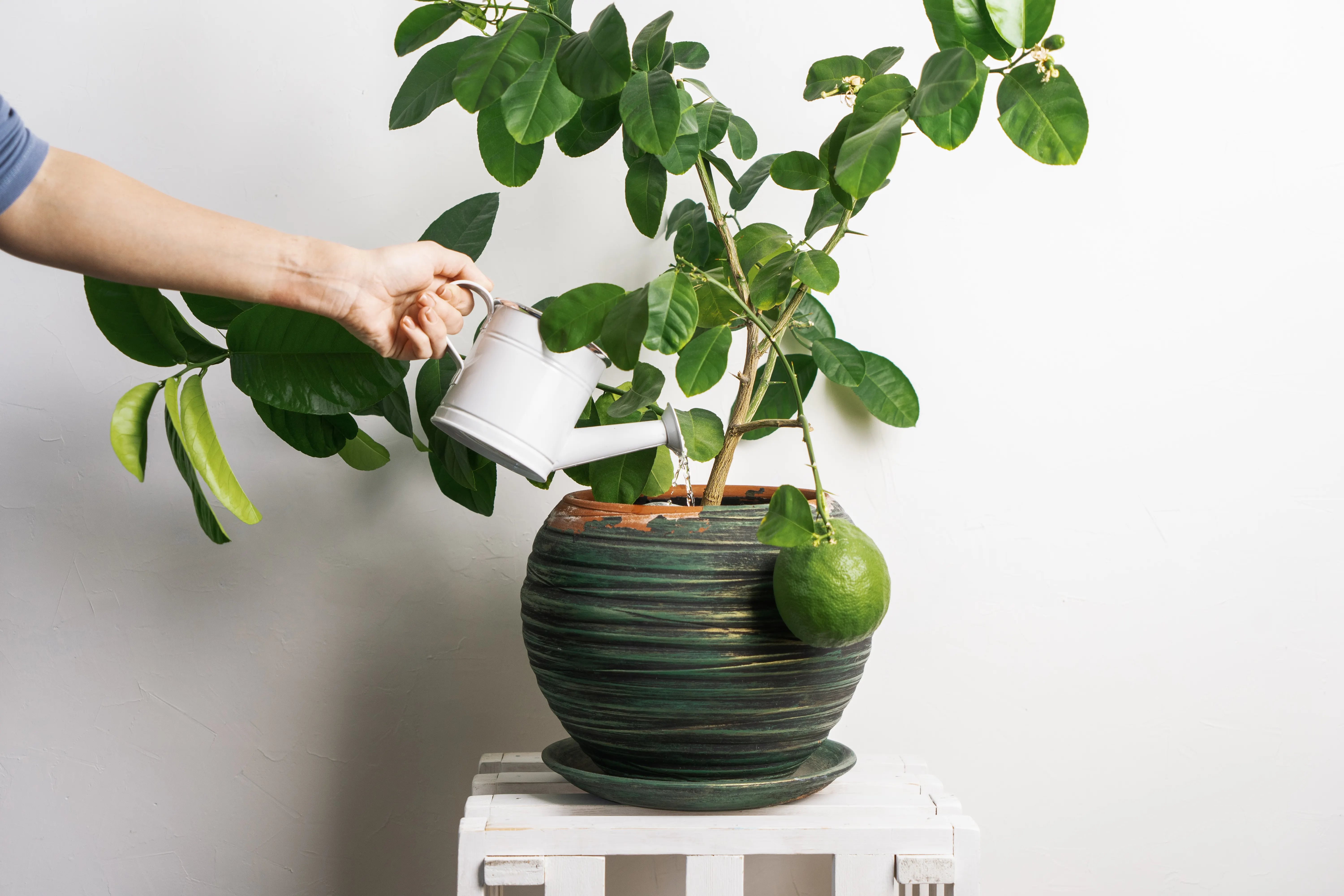
Lemon trees are small evergreen trees that produce fragrant white flowers and yellow fruits. They are commonly grown for their fruit but also make great indoor trees due to their pleasant fragrance and attractive foliage.
Maintenance level: Moderate
Benefits:
- Lemon trees can purify the air.
- Their fragrance can calm moods and reduce stress.
- This indoor tree is also a source of fresh, organic fruit that can be used in cooking or for making drinks.
Suitable Spot: Lemon trees prefer a spot with bright, indirect sunlight and good airflow near a sunny window or balcony.
How to maintain it: Lemon trees require regular watering, but be careful not to overwater, as this can lead to root rot. These indoor trees must be fertilised regularly during the growing season and pruned to maintain their shapes and sizes. Lemon trees are sensitive to cold environments and may need to be moved to a warmer location during winter.
13. Ficus Alii
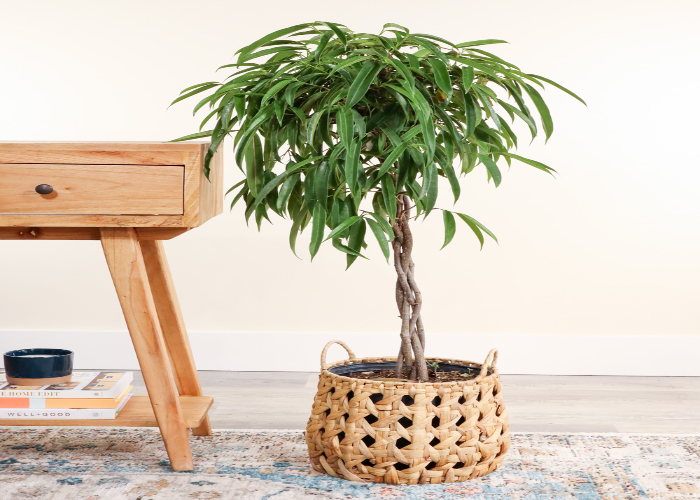
The Ficus Alii, also known as the “Alii” or “Long-leaved fig,” is a low-maintenance houseplant with long, narrow, shiny green leaves. It is a tropical plant native to Asia and Australia, and it can grow up to 10 feet tall indoors with proper care.
Maintenance Level: Moderate
Benefits:
- The Ficus Alii is also known for its air-purifying abilities.
- It removes toxins such as formaldehyde, benzene, and trichloroethylene from the air, making it a great indoor tree.
- Its graceful arching branches also add a touch of natural beauty to any room.
Suitable Spot: The Ficus Alii prefers bright, indirect light but can also tolerate low light conditions. It’s best to avoid direct sunlight to prevent leaf burn. It thrives in warm, humid environments and should avoid drafts.
How to Maintain it: The Ficus Alii prefers evenly moist soil and should be watered when the top inch of soil feels dry to the touch. It’s important not to overwater, as this can cause root rot. Pruning this indoor tree can help control the size and shape of the plant, and occasional fertilisation can encourage growth.
14. Dragon Tree
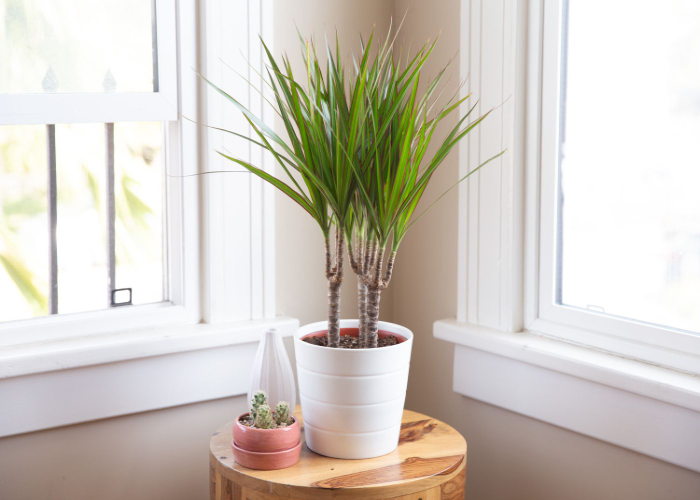
The Dragon Trees, or Dracaena Marginata, are striking, low-maintenance indoor trees with long, narrow, pointed leaves resembling a dragon’s tail. It’s native to Madagascar and is one of the most popular indoor plants due to its hardiness and beauty.
Maintenance Level: Easy
Benefits:
- The Dragon Tree is an air-purifying plant.
- It’s also a great plant for beginners as it’s low-maintenance and can tolerate a range of light and humidity levels.
Suitable Spot: The Dragon Tree prefers bright, indirect light, but it can also tolerate low light conditions. It’s best to avoid direct sunlight to prevent leaf burn. It thrives in warm, humid environments and should avoid drafts.
How to Maintain it: The Dragon Tree prefers well-draining soil and should be watered when the top inch of soil feels dry to the touch. It’s important not to overwater, as this can cause root rot. Pruning can help control the size and shape of the plant, and occasional fertilisation can encourage growth.
15. Philodendron
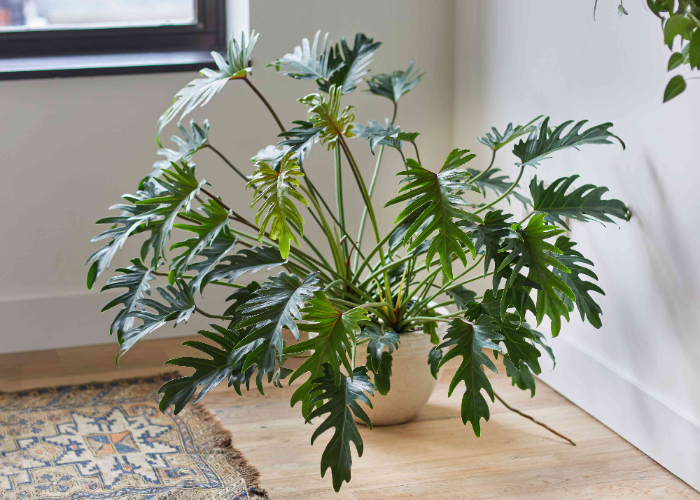
The Philodendron is a popular indoor plant with blade-shaped leaves in a heart structure. It comes in various shades, from dark green to burgundy. It is a native plant of Central and South America and is known for its easy care and adaptability to different environments.
Maintenance Level: Easy
Benefits: The Philodendron is an air-purifying plant.
Suitable Spot: The Philodendron prefers bright, indirect light but can also tolerate low light conditions. It’s best to avoid direct sunlight to prevent leaf burn. These indoor trees thrive in warm, humid environments and should avoid drafts.
How to Maintain it: The Philodendron prefers well-draining soil and should be watered when the top inch of soil feels dry to the touch. It’s important not to overwater these indoor trees, as this can cause root rot. Pruning can help control the size and shape of the houseplant.
16. Areca Palm
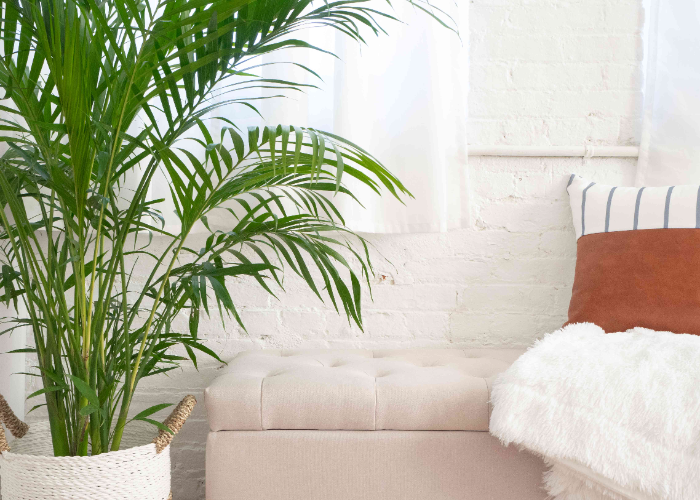
Areca palm, also known as Dypsis lutescens or yellow butterfly palm, is a popular houseplant that adds a tropical touch to any room. The palm features multiple trunks and feathery fronds that can grow up to 8 feet long. This plant is native to Madagascar and grows well in bright, indirect light with regular watering.
Maintenance level: Moderate
Benefits:
- Aceca palm helps to purify the air by removing harmful toxins such as formaldehyde, xylene and toluene.
- It is also believed that it helps to humidify the air, which can benefit people with dry skin or respiratory issues.
Suitable Spot:
Areca palm needs bright, indirect light and prefers to be kept in a humid environment. It can tolerate lower light conditions but may not grow as well.
How to maintain it:
Areca palm requires watering once a week or when the top inch of soil is dry to the touch. It prefers well-draining soil and benefits from occasional fertilisation during the growing season.
17. Parlour Palm

Parlour palm, or Chamaedorea elegans, is a small palm native to Mexico and Guatemala. It has delicate, arching fronds that can grow up to 4 feet long, making it a great choice for tabletops and shelves. The plant is slow-growing and can take several years to reach its mature size.
Maintenance level: Easy
Benefits:
- Parlour palm is known for its air-purifying properties.
- A low-maintenance plant that is easy to care for.
Suitable Spot: Parlour Palm thrives in bright, indirect light but can tolerate lower light conditions. It prefers to be kept in a humid environment and can benefit from occasional misting.
How to maintain it: Parlour palm thrives in bright, indirect light but can tolerate low-light conditions. It prefers to be kept evenly moist, but be careful not to overwater as this can lead to root rot. The plant can benefit from occasional fertilisation during the growing season.
18. Yucca
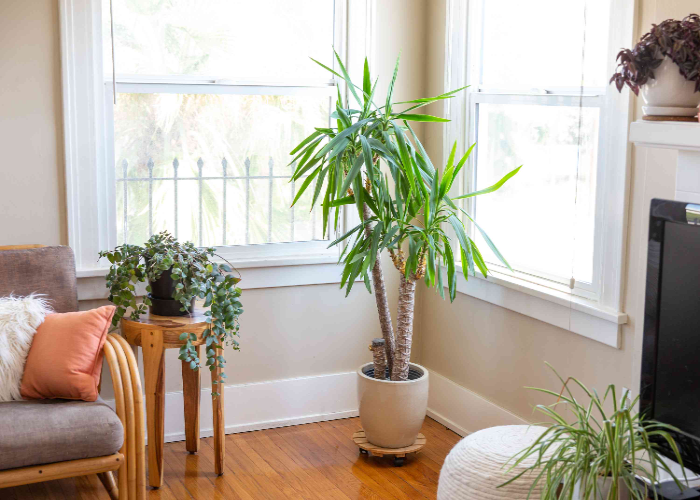
Yucca is also known as Yucca elephantipes. It is a large tree-like indoor plant native to Central America and Mexico. It has thick leaves which are shaped like a sword.
Maintenance level: Easy
Benefits:
- Yucca needs low maintenance and can survive without water for a long period.
- Excellent air purifier
Suitable Spot: Yucca thrives in bright, direct sunlight but can tolerate lower light conditions. It prefers to be kept in a well-draining soil mix and can benefit from occasional misting.
How to maintain it: Yucca survives in bright, indirect light and prefers to be kept dry, so be careful not to overwater. It can tolerate a wide range of temperatures, but the warm temperature suits it. This indoor plant can get benefits from occasional fertilisation during the growing season.
19. Pachira Aquatica
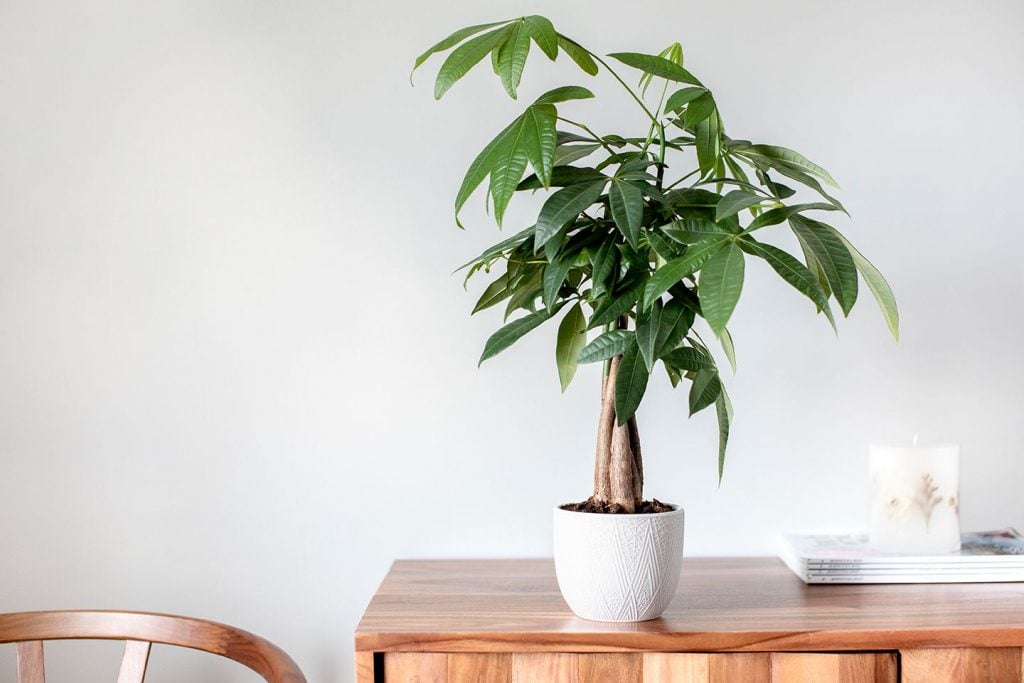
Pachira Aquatica is commonly known as the Money Tree. This tropical indoor plant has a braided trunk and glossy green leaves. It is believed to bring good luck and prosperity to the owner. This plant is native to Central and South America, and it grows in This plant is native to Central and South America and grows in miry areas.
Maintenance level: Easy
Benefits:
- The Money Tree is believed to bring good luck and prosperity to the owner.
- An excellent air purifier, removing toxins such as formaldehyde and benzene.
Suitable spot: This plant thrives in bright, indirect light and prefers to be kept in a warm, humid environment. It is best suited for a spot near a window that receives bright, filtered light.
How to maintain it: Water the plant once a week, letting the soil dry out between waterings. It is also important to avoid overwatering, as this can lead to root rot. The Money Tree can be pruned to control its size and shape, and it benefits from occasional fertilisation during the growing season.
20. Calathea
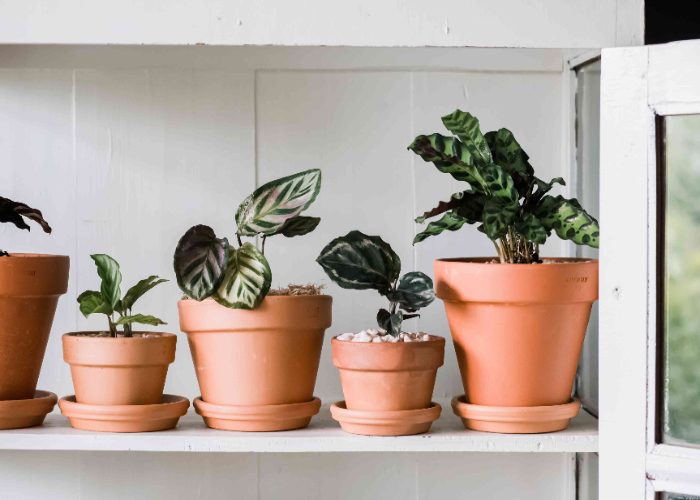
Calathea, also known as Prayer Plant, is a beautiful and popular houseplant with striking foliage in various colours and patterns. The leaves of this plant fold up at night, resembling hands in prayer, which gives it the common name of the Prayer Plant.
Maintenance level: Moderate
Benefits:
- Excellent air purifier
- Removing harmful toxins such as formaldehyde and benzene from the air.
- Believed to have stress-reducing properties and is commonly used in Feng Shui practices.
Suitable spot: This plant prefers low to medium light and should be kept away from direct sunlight. It also requires high humidity levels, so it is best suited for a bathroom or near a humidifier.
How to maintain it: Keep the soil moist but not waterlogged, and mist the leaves regularly to maintain high humidity levels. Calathea is sensitive to chlorine and fluoride, so it is best to use filtered water when watering. This plant also benefits from occasional fertilisation during the growing season.
21. Schefflera
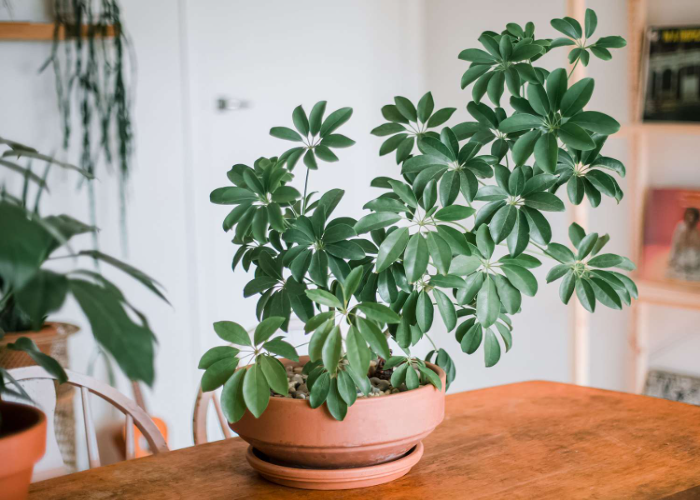
Schefflera, also known as the Umbrella Tree, is a popular houseplant with glossy green leaves that resemble an umbrella. It is native to Australia and Southeast Asia and can grow up to 8 feet tall indoors.
Maintenance level: Easy
Benefits:
- The Schefflera is an excellent air purifier
- It is also believed to have stress-reducing properties and can help to boost productivity.
Suitable spot: This plant thrives in bright, indirect light and prefers to be kept in a warm, humid environment. It is best suited for a spot near a window that receives bright, filtered light.
How to maintain it: Watering this plant once a week is sufficient. Just make sure the soil dries out completely when you water next time. The Schefflera are pruned to control their size and shape. It benefits from occasional fertilisation during the growing season.
22. Christmas Cactus

The Christmas Cactus is a popular houseplant that blooms during the holiday season, producing colourful, tubular flowers in shades of pink, red, and white. It is native to the rainforests of Brazil and is a popular gift during the holiday season.
Maintenance level: Easy to moderate
Benefits:
- The Christmas Cactus is not only beautiful to look at, but it can also improve air quality by filtering out toxins and pollutants in the air.
- It is also known to have calming effects.
Suitable spot: The Christmas Cactus prefers bright but indirect sunlight and temperatures between 60-70°F. It can be placed in a living room or bedroom near a window that doesn’t receive direct sunlight.
How to maintain it: Water your Christmas Cactus regularly, but be careful not to overwater it, as it can cause root rot. Allow the soil to dry slightly between waterings. Additionally, the Christmas Cactus requires a period of darkness to initiate blooming, so avoid exposing it to bright lights at night.
Why Do You Need Plants in Your Home?
All in all, indoor plants and trees add aesthetic appeal to homes and offices and provide numerous health benefits. However, choosing the best indoor plants for your living space can be overwhelming with so many options available.
In this article, we have highlighted the 22 best indoor plants and trees, their maintenance level, benefits, suitable spot, and how to maintain them. From the popular Fiddle Leaf Fig to the unique Chinese Money Plant, this guide is perfect for beginners and experienced plant enthusiasts.
So, bring a touch of nature and enjoy the beauty of these fantastic indoor trees and plants.

